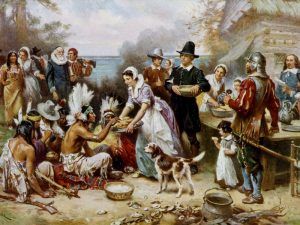Haleema Shah in Smithsonian:
 Native Americans are only one percent of the population, but their images are on our boxes of butter and cornstarch. Their names are used to sell motorcycles and cars. And one of their brief encounters with English colonists is the basis of one of our biggest holidays. The story of Thanksgiving definitely evolved over time. The First Thanksgiving of 1621 happened but with little notice or attention. Curators at the Smithsonian’s National Museum of the American Indian like to call it “a brunch in the forest.” Yes, it took place between Native Americans and Pilgrims. But the event was not exempt from history’s subjectivity. “What historians have had trouble explaining to civilians is that history is always a narrative. It always has a level of fiction in it,” says the Smithsonian’s Paul Chaat Smith. “That’s why the term ‘revisionist’ never really works,” he adds. “Because all history changes over time.” Smith is a co-curator of the National Museum of the American Indian’s highly acclaimed exhibition “Americans,” which opened earlier this year, and a featured guest on the recently released Smithsonian Sidedoor podcast, “That Brunch in the Forest.”
Native Americans are only one percent of the population, but their images are on our boxes of butter and cornstarch. Their names are used to sell motorcycles and cars. And one of their brief encounters with English colonists is the basis of one of our biggest holidays. The story of Thanksgiving definitely evolved over time. The First Thanksgiving of 1621 happened but with little notice or attention. Curators at the Smithsonian’s National Museum of the American Indian like to call it “a brunch in the forest.” Yes, it took place between Native Americans and Pilgrims. But the event was not exempt from history’s subjectivity. “What historians have had trouble explaining to civilians is that history is always a narrative. It always has a level of fiction in it,” says the Smithsonian’s Paul Chaat Smith. “That’s why the term ‘revisionist’ never really works,” he adds. “Because all history changes over time.” Smith is a co-curator of the National Museum of the American Indian’s highly acclaimed exhibition “Americans,” which opened earlier this year, and a featured guest on the recently released Smithsonian Sidedoor podcast, “That Brunch in the Forest.”
Many Americans are familiar with the early story of English colonists, or Pilgrims, coming to North America aboard the Mayflower. Many died from starvation and disease, and the rest struggled to survive a cold winter. The school play version of Thanksgiving tells the story of a landmark moment of coexistence, multiculturalism and even neighborliness when Native Americans taught Pilgrims to farm, and shared a meal with them after a successful harvest in 1621. But it wasn’t a landmark moment—Smith describes it as a nonevent that was recorded in the writings of early English settlers, but likened it to more of a historic footnote. “They didn’t repeat it the next year,” Smith says. “It wasn’t special and some people knew that it happened, but it was forgotten for hundreds of years until the 1800s.” And that could be because Thanksgiving was never a very original idea to begin with. Long before 1621, Native Americans held celebrations and dances around a harvest, and Europeans also held church-style services to give thanks.
More here.
